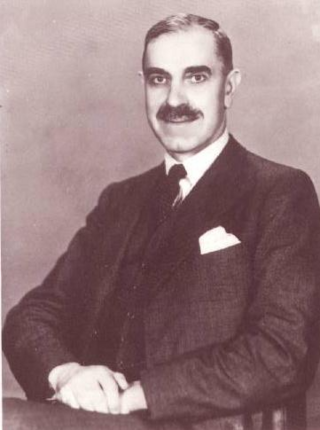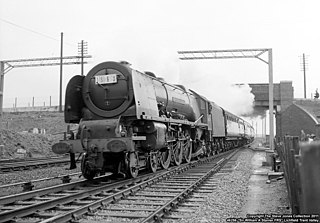
The LMS Coronation Class No. 6220 (British Railways No. 46220) Coronation was a British steam locomotive.

The LMS Coronation Class No. 6220 (British Railways No. 46220) Coronation was a British steam locomotive.

6220 was built in 1937 at Crewe Works, the first of its class of streamlined locomotives. It, along with others were given a special livery of Caledonian Railway blue with go-faster stripes instead of the more conventional red. [1]
During a press run on 29 June 1937, 6220 set a new speed record on the West Coast Main Line. Driver TJ. Clark and fireman C. Lewis (with Robert Riddles (engineer) and inspector S. Miller on the footplate), pushed the Stanier pioneer to a claimed speed of 114 miles per hour on Madeley Bank south of Crewe, which broke the previous record of 113 mph set by the rival LNER. [2]
However, the celebration was premature, as the footplate team realised the train was still making 110 mph only a mile and a half from Crewe station. Urgent braking improved matters, but the locomotive passed through the station's reverse curves at 57 mph, well in excess of the 20 mph limit; the resultant buffeting alarmed the passengers and knocked loose various dishes and utensils in the dining coach. [3] [4]
Though the record now lay with the LMS, the scare led to both companies declaring an unofficial truce. This was only broken the following year by the LNER with A4 Class 4468 Mallard, which reached 126 mph whilst trialling a new quick action braking system.
In 1939, 6220 temporarily swapped identities with 6229 Duchess of Hamilton. The new Coronation was sent on a tour to America for the World's fair. There was thus a blue 6229 Duchess of Hamilton in Great Britain and a red 6220 Coronation in the United States. On the return of the engine from North America, their identities were swapped back again. [5]
6220 swapped its single chimney for a double chimney in December 1944. The streamlining was removed for maintenance reasons in September 1946, and smoke deflectors were installed during maintenance. [6] It was painted LMS 1946 black livery in September 1947, followed by BR standard express blue from January 1950 to April 1952. It was painted BR green in April 1952. 46220 remained in semi-streamlined form with sloping smokebox front until February 1957 when a round-topped smokebox was fitted. 46220 was never painted maroon and was in BR green when withdrawn.
46220 was withdrawn in 1963 and scrapped at Crewe Works. [7]

The LNER Class A4 is a class of streamlined 4-6-2 steam locomotive designed by Nigel Gresley for the London and North Eastern Railway in 1935. Their streamlined design gave them high-speed capability as well as making them instantly recognisable, and one of the class, 4468 Mallard, holds the record as the world's fastest steam locomotive. Thirty-five of the class were built to haul express passenger trains on the East Coast Main Line route from London Kings Cross via York to Newcastle, and later via Newcastle to Edinburgh, Scotland. They remained in service on the East Coast Main Line until the early 1960s when they were replaced by Deltic diesel locomotives; they themselves proving to be worthy successors to the A4s. Several A4s saw out their remaining days until 1966 in Scotland, particularly on the Aberdeen – Glasgow express trains, for which they were used to improve the timing from 3.5 to 3 hours.

The 4073 or Castle Class are 4-6-0 steam locomotives of the Great Western Railway, built between 1923 and 1950. They were designed by the railway's Chief Mechanical Engineer, Charles Collett, for working the company's express passenger trains. They could reach speeds of up to 100 mph (160 km/h).

The London, Midland and Scottish Railway (LMS) Princess Royal Class is a class of express passenger 4-6-2 steam locomotive designed by William Stanier. Twelve examples were built at Crewe Works, between 1933 and 1935, for use on the West Coast Main Line. Two are preserved.

The London, Midland and Scottish Railway (LMS) Coronation Class is a class of express passenger steam locomotives designed by William Stanier. They were an enlarged and improved version of his previous design, the LMS Princess Royal Class, and on test were the most powerful steam locomotives ever used in Britain at 2,511 dbhp. The locomotives were specifically designed for power as it was intended to use them on express services between London Euston and Glasgow Central; their duties were to include the hauling of a proposed non-stop express, subsequently named the Coronation Scot. The first ten locomotives of the Coronation class were built in a streamlined form in 1937 by the addition of a steel streamlined casing. Five of these ten were specifically set aside to pull the Coronation Scot. Although a later batch of five unstreamlined locomotives was produced in 1938, most of the ensuing Coronation class were outshopped as streamliners. From 1944 until production ended in 1948, all-new engines were built in unstreamlined form and all the streamliners had their casings removed. The last of the 38 locomotives was completed in 1948.

The LMS Turbomotive was a modified LMS Princess Royal Class steam turbine locomotive designed by William Stanier and built by the London, Midland and Scottish Railway in 1935. It was inspired by the Swedish Ljungström locomotives first introduced in 1922. It used turbines instead of cylinders. It was later rebuilt as a conventional locomotive No. 46202 Princess Anne.

Sir William Arthur Stanier, was a British railway engineer, and was chief mechanical engineer of the London, Midland and Scottish Railway.

The steam locomotives of British Railways were used by British Railways over the period 1948–1968. The vast majority of these were inherited from its four constituent companies, the "Big Four".

The BR Standard Class 7, otherwise known as the Britannia Class, is a class of 4-6-2 Pacific steam locomotive designed under Robert Riddles for use by British Railways for mixed-traffic duties. 55 were constructed between 1951 and 1954. The design employed results from the 1948 locomotive exchanges undertaken in advance of further locomotive classes being constructed. Three batches were constructed at Crewe Works, before the publication of the 1955 Modernisation Plan.

The LSWR N15 class was a British 2–cylinder 4-6-0 express passenger steam locomotive designed by Robert Urie. The class has a complex build history spanning three sub-classes and ten years of construction from 1918 to 1927. The first batch of the class was constructed for the London and South Western Railway (LSWR), where they hauled heavy express passenger trains to the south coast ports and further west to Exeter. After the Lord Nelsons, they were the second biggest 4-6-0 passenger locomotives on the Southern Railway. They could reach speeds of up to 90 mph (145 km/h).

The London, Midland and Scottish Railway (LMS) Stanier Class 5 4-6-0, commonly known as the Black Five, is a class of 4-6-0 steam locomotives. It was introduced by William Stanier and built between 1934 and 1951. A total of 842 were built initially numbered 4658-5499 then renumbered 44658-45499 by BR. Several members of the class survived to the last day of steam on British Railways in 1968, and eighteen are preserved.

The London Midland and Scottish Railway (LMS) Stanier Class 5 2-6-0 or Stanier Mogul is a class of 2-6-0 mixed traffic steam locomotives. Forty were built between October 1933 and March 1934.

60007 Sir Nigel Gresley is an LNER Class A4 4-6-2 ("Pacific") steam locomotive built to a design of Sir Nigel Gresley in 1937 at Doncaster Works for operation on the London and North Eastern Railway (LNER). The locomotive holds the post-war speed record for steam locomotives on British Railways. The locomotive was withdrawn from service in 1966 and purchased for preservation the same year; it is one of six A4s to be preserved.

London Midland and Scottish Railway (LMS) Coronation Class 6229Duchess of Hamilton is a preserved steam locomotive built in September 1938 by the LMS Crewe Works and operated until February 1964.

LNER Class A4 2509 Silver Link was a 4-6-2 "Pacific" built in 1935 for the London and North Eastern Railway. It was the first of the Streamlined Class A4s built to haul express passenger trains on the East Coast Main Line (ECML). 2509 was one of four A4s to be painted in a special silver livery to pull a new train called the Silver Jubilee.

The Coronation Scot was a named express passenger train of the London, Midland and Scottish Railway inaugurated in 1937 for the coronation of King George VI and Queen Elizabeth which ran until the start of the war in 1939. It ran on the West Coast Main Line between London and Glasgow, stopping at Carlisle for crew change and to pick up and set down passengers to and from London only. The service was designed to compete with the rival services on the East Coast Main Line, for prestigious London to Scotland traffic. It was scheduled to complete the journey from London to Glasgow in 6 hours 30 minutes.

LMS Princess Coronation Class 46233 Duchess of Sutherland is a steam locomotive built in 1938 for the London, Midland and Scottish Railway (LMS) at Crewe Works to a design by William Stanier. It is a 4-6-2 Pacific locomotive built as part of the LMS Coronation Class for its express passenger services, including the Royal Scot service from London to Glasgow.

London Midland and Scottish Railway Princess Coronation Class No. 6256Sir William A. Stanier F.R.S. was a British steam locomotive.

London Midland and Scottish Railway (LMS), Coronation Class, LMS No. 6235, British Railways No. 46235 City of Birmingham is a preserved British steam locomotive.

The streamlined East Anglian service of the London and North Eastern Railway was introduced on 27 September 1937, soon after the Coronation and the West Riding Limited, but differed from those – and from the Silver Jubilee of 1935 – in several respects. It did not use new Class A4 4-6-2 locomotives but instead existing Class B17 4-6-0s were given a streamlined casing; although new carriages were built, these were neither articulated nor streamlined; there was no special livery; it ran at speeds not much greater than those achieved by existing expresses on the Norwich line; and there was no supplementary fare.

A double chimney is a form of chimney for a steam locomotive, where the conventional single opening is duplicated, together with the blastpipe beneath it. Although the internal openings form two circles, the outside appearance usually forms a single elongated oval.